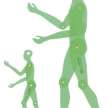
ORIGAMI
Japanese meaning
Ori = Folding, folded . G[k]ami = Paper = Folded paper
Latin meaning
Ori =To rise, arising, to be born, source, original, to ascend, to Spring up, to become visible, and to appear . Ami = friend, friendly; loveable; goodwill, cordial; peaceful relations
So, all together - origami embodies a peaceful place.
Origami means folding paper in Japanese. In Chinese, the word for paper folding is zhézhǐ. Origami is the art and science of taking a square piece of paper and altering it into a 2D or 3D shape. Paper was invented in China and in 105 A.D. it was credited to Ts’ai Lun. Paper was introduced to Japan in the late sixth century. For many centuries, the sharing of traditional origami designs was done aurally. There are no known ancient records of paper folding in Chinese literature; however, there are two known Japanese published books from the 1700s. The first book published in 1764 is about ceremonial origami, and in 1797 a recreational origami book followed. Origami also made its way to Spain in the 1100s through the Arab people. At that time, many Arabs were Muslim and deeply religious. Since the religion forbade representations of animate objects, as masters of mathematics they used paper folding techniques to study geometry. Japanese paper folding is focused on nature and beauty with models mimicking cranes, people, and flowers. Chinese paper folding is focused on practical items such as boats, boxes, and cups. In 1948 Chinese origami master Maying Soong published, The Art of Chinese Paper Folding for Young and Old. And in the 1950s Akira Yoshizawa (Japanese) and Sam Randlett (American) popularized origami through the publications of clear instructional diagrams of folds and symbols, that are still used today.
Although origami can be an entertaining arts and crafts activity to occupy bored children, the truth is that the practice of paper folding also provides serious benefits such as being an accessible self-improvement tool, improving spatial abilities, solving engineering problems, and helping to overcome a variety of disability challenges.
Yes! Would you believe that the art of paper folding (origami) has over forty benefits beyond amusing arts and crafts? As mentioned, origami is the art and science of taking a square piece of paper and altering it into a 2D or 3D shape. Although origami can be an entertaining arts and crafts activity, the practice of paper folding also provides serious benefits such as being an accessible self-improvement tool, inner peace, improving spatial abilities, and helping to overcome a variety of disability challenges.
BENEFITS OF ORIGAMI
• Active mindfulness (folding meditation)
• Develops focus, clarity, concentration, attention, logic, and precision
• Confidence and accomplishment: Learning and success at a new skill
• Improves hand and eye coordination, fine motor skills, vision, and spatial abilities
• Initiates conversation, peaceful co-operation, connection, and a sense of belonging
• Stimulates feelings of acceptance, and non-judgment
• Promotes creativity, imagination, patience, persistence, sharing, positive emotions, self-esteem, social and knowledge skills
• Facilitates learning, problem-solving, communication, goal setting
• Reinforces sequential thinking, and following directions, STEAM concepts
• Opportunity for fun, play, friendship, healing, relaxation, and gift-giving
• Alleviates boredom, barriers, and loneliness
• Receives positive feedback and reinforcement, and a non-threatening bridge to therapeutic dialogue
Origami encourages mindfulness, self-acceptance, focus, and connection. Wei (2016) states that it can take time to learn how to re-create a shown model. Starting with a simple model can increase confidence. Mistakes are meant to happen so during the process of origami it helps the paper folder to let go of self-judgment, self-criticism, and perfectionism. However, with repetitive origami practice, accurate folding progress is naturally achieved. Furthermore, success is found when accurately following instructions, such as learning the basic symbols and bases of origami. A sense of accomplishment, improved self-esteem, and proficiency occur. She also mentions that even if the practice of origami is done alone, it affects others too. As a model is folded, conscious positive thoughts about someone can take place. This action can be a form of compassionate meditation. In addition, after the model is completed, it can be given away to the person that was contemplated. With these points in mind, we learn that origami can be used as a tool for mindfulness and self-improvement. Moreover, origami is a novel way to practice meditation.
Origami can also be used to help students with disabilities to improve their academic, physical impairments, and life skills. Sze (2005) shares that origami can improve the attention span and concentration of people experiencing ADHD, people with Autism receive help in learning how to follow logical and fixed instructions step by step, and those who have traumatic brain injuries can improve their memory and organization skills. In addition, Wei (2016) asserts that special needs children (such as those with ADHD) might improve their attention and focus, while folding paper, by being in the present and focusing on what they’re doing with the paper. Additionally, Sze (2005) discovered that the life laws are taught as participants fold the paper and become more patient, engage in acts of discipline and order, focus on precision, and experience pleasant group harmony. Also, at-risk students can benefit from using origami to improve ongoing social, behavioral, self-management, academic, and life skills problems. Furthermore, stress and anger are reduced for students who have been diagnosed with mood and behavioral disorders. Physical impairments, such as motor skill problems, also benefit from working with origami. It is important to know what the benefits of origami are and its impact on various disabilities, how to use it in instruction, and to merge it into special education services so that students can have another tool to help them overcome their challenges.
Finally, many Asian countries have incorporated origami-based instruction in elementary school mathematics classes, and this makes sense because of the benefits of improved spatial abilities and enhancement of math lessons. Cakmak, Isiksal, & Koc (2013) state that origami can be a useful instructional tool to improve spatial skills because it utilizes awareness of shapes and has a geometrical connection as one folds the paper into 2D and 3D models. They share that some mathematical terms reported being used in the math classes, while the students received origami-based instruction, were: “square, angles, diagonal, pentagon, trapezoid, quadrilateral, symmetry, hexagon, geometrical object, fractions, rhombus, deltoid, area, length, and rotation”. Participants were interviewed, and 94.7% said that using origami to instruct them in math and geometry classes was beneficial because of its connection to mathematics. It also helped them understand complex concepts in a hands-on, visual, and fun way. The researchers state that active involvement in the creative process of paper folding, while learning geometry concepts, positively contributes to improved spatial and orientation skills development. The evidence suggests that it would be wise to include origami-based instruction in the standard elementary school curriculum, as it improves education.
Based on the evidence provided in this essay, origami can provide a great number of benefits, such as improving academic skills and having a therapeutic value. Origami can improve cognition, health, wellness, and disabilities (social, physical, and mental). Therefore, origami is more than a simple arts and crafts tool to entertain children when they’re bored or wanting to create something, origami is a valuable life hacking and mindful meditation tool for all ages.
References
Cakmak, S., Isiksal, M., & Koc, Y. (2013). Investigating Effect of Origami-Based Instruction on Elementary Students' Spatial Skills and Perceptions. The Journal of Educational Research, 107 (1), 59-68.
Sze, S. (2005, 03 17). Effects of Origami Construction on Children with Disabilities. Lewiston, New York, United States.
Wei, M. (2016, 09 02). 5 Ways Origami Boosts Mindfulness. Retrieved 07 01, 2017, from Psychology Today: https://www.psychologytoday.com/blog/urban-survival/201609/5-ways-origami-boosts-mindfulness
About the Creator
A.S.L.
Mature U of T student who loves researching and writing about social stuff. Gender non-conforming. Interested in futurism, technology, health and wellness, the arts, astrology, dating, mating, and relating. Hobbyist creative writer.






Comments
There are no comments for this story
Be the first to respond and start the conversation.